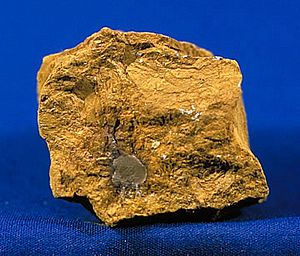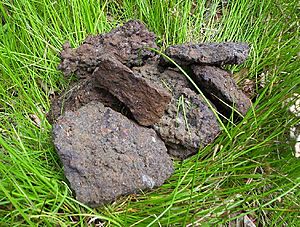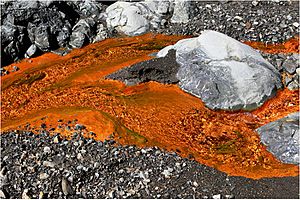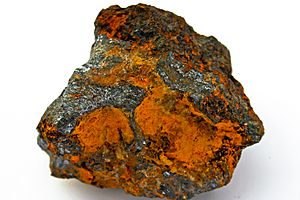Limonite facts for kids
Limonite is a common mineral that looks like rust. It's actually a mix of different iron minerals. People can get iron from it, even though it's not pure iron. You can find it all over the world, often in places where water and other minerals have reacted with iron.
Contents
What is Limonite Like?
Limonite is quite heavy for its size. Its color can be bright yellow, like a lemon, or a dull brownish-gray. If you rub limonite on a rough surface, it always leaves a brownish streak. This helps tell it apart from other iron minerals like hematite (which leaves a red streak) or magnetite (which leaves a black streak). Limonite is not super hard; you can usually scratch it with a knife.
A Mix of Minerals
Even though we call it "Limonite," it's actually a blend of several different iron minerals. These include goethite, akaganeite, lepidocrocite, and jarosite. While these individual minerals can form crystals, limonite itself usually doesn't. Instead, it often looks like fibers, tiny grains, or rounded lumps. Sometimes it forms in shapes like grapes or icicles. Because it often forms in wet places, limonite can look like clay or mud.
Minerals That Change Shape
Sometimes, limonite can form "pseudomorphs." This is a cool word that means "false shape." It happens when limonite replaces another mineral, but keeps the original mineral's shape. For example, a pyrite crystal might turn into limonite, but it still looks like a pyrite crystal on the outside. This happens when water and chemicals change the pyrite into limonite. Limonite can also form pseudomorphs from other iron minerals or even from garnets.
How Limonite Forms
Limonite often forms when other iron minerals, like hematite and magnetite, get wet and change. It also forms when iron-rich minerals, like olivine or pyroxene, break down due to weather. You can often find limonite in reddish-brown soils called lateritic soils. It can also be found in streams that flow from mining areas.
Uses of Limonite
People have used limonite for a long time.
Natural Colors
One of the first uses for limonite was as a pigment, which is a natural color. The yellow kind of limonite makes a yellow color called ochre. People used this for painting. If you heat limonite, it changes into hematite, which is red. This is how people made red ochre, burnt umber, and sienna colors.
Source of Iron
Limonite found in swamps, called "bog iron ore," and limonite mudstones were once mined to get iron. Today, most countries don't mine these types of limonite for iron anymore.
Finding Other Minerals
Sometimes, thick layers of limonite form on top of other valuable ore deposits. These layers are called "iron caps" or "gossans." Early miners used these iron caps as clues to find hidden ore deposits underground. If these deposits contained gold, the gold would sometimes get concentrated in the limonite. This made the limonite itself valuable to mine for gold. For example, gold was mined from limonite-rich soils in places like Dahlonega, Georgia, and parts of Brazil.
History of Limonite Use
The very first iron used by humans probably came from meteorites. Hematite was also easier to melt and use. However, in Africa, where iron use first started, limonite was the most common iron ore.
When people first started melting iron, they would heat the limonite ore. This heating would remove the water from the limonite, turning more of it into hematite. Then, they would pound the hot ore. As the iron got hotter, it would start to stick together, and impurities would fly off as sparks. Early iron-making systems, especially in places like Tanzania, were quite complex for processing limonite.
For a long time, hematite and magnetite were the preferred ores for simple furnaces called "bloomeries." It wasn't until the invention of the blast furnace—first in China around 100 BCE and later in Europe around 1150 CE—that limonite could be used much more effectively to make iron.
See also
 In Spanish: Limonita para niños
In Spanish: Limonita para niños







